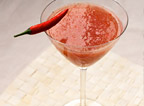
My best friend Krista is moving to Boston this week to start Harvard Law school and she came to visit me in New York for her last weekend outside of a library. I really wanted to show her a good time in the city. I got us on the list for a party at the Tribeca Grand hotel. I didn't know it was going to be such a big deal, but a band was playing that Mark Ronson produced. Next thing I know, Mark Ronson is standing right next to me and Nate is talking to Mischa Barton (crazy Marisa from the OC). He offered to buy her a drink, which as I told him later, was not such a good idea because according to Perez Hilton she just got out of rehab. The girl who checked our names at the door had a red sequin shirt on with shoulder pads glued on the outside, if you can picture her, you can picture this crowd.
Krista and I met in Chinese class in college and we bonded as the only two white girls in the class completely new to Mandarin Chinese. We ended up studying abroad together in Nanjing and we both love eating Chinese food. She's been living in India for the past year working as an intern at a law office and she hasn't had good chinese food for a year. That's why Nate and I wanted to cook our favorite dinner party meal for her-- sichuan hot pot.
Nate made a different broth and a different sauce than we normally make. Both were a disappointment. The broth wasn't nearly as spicy as we wanted it (even though we dumped in two bottles of chili sauce and a bunch of sichuan peppercorns). It's frustrating when you have people over to eat and the food sucks. It wasn't a disaster, just bland. Note to self: it's not a good idea to make up a new recipe when people are coming over to eat whatever you come up with in two hours. We're going to have another dinner party again soon and we'll make the broth spicy enough even for a restaurant in Sichuan, China to serve-- the kind of steaming pot that is so spicy everyone at the table is crying. I also think adding cumin and a few other spices in there as well will make it more flavorful.
The main reason I think dinner could have better is if we had served Mongolian peanut dipping sauce for people to dip the vegetables and meat they cooked in the pot into. The sesame paste sauce is great, but only if the broth in the pot has a balancing strong spicy flavor. The Mongolian peanut sauce is good enough to eat with a spoon.
-mary kate
Here's our recipe, smooth and delish:
Peanut Butter Dipping Sauce for Chinese Hot Pot
½ cup peanut butter
1 tablespoon light soy sauce
1 tablespoon chili bean paste
2 teaspoons sugar
¼ cup hot water
fresh cilantro
Whisk together peanut butter, soy sauce,
chili bean paste, sugar, and hot water in a mixing
bowl. Spoon equal amounts of sauce into 4 small
serving bowls and top with a heap of chopped
cilantro. Give each guest a bowl of sauce and a
bowl of white rice.



 appetizers snacks,
appetizers snacks,  recipes,
recipes,  sauces,
sauces,  sides
sides 













